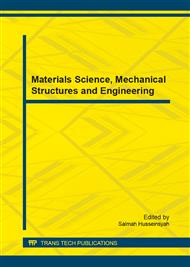[5]
. It finds through time history analysis that All point tower under the conditions of geometric nonlinearity ,The change of displacement of the vibration amplitude is very clear ,sores by 30 percent generally. Straight line towers in the first four cycles of vibration mode is as follows: Straight line tower first vibration mode Straight line tower second vibration mode Straight line tower third vibration mode Straight line tower fourth vibration mode From the above, it can be seen that Structural vibration mode is symmetric and antisymmetric state ,There is no single bar is revealing,which shows structural connections in good condition and then the correctness is surly verified. The following is the comparison of each point line tower nonlinear displacement time history,red curve stands for the linear time history ,and blue curve stands for nonlinear time history。 Gradient optimization Dao heng full stress analysis software engineering software is adopted to establish the model of successive is optimized, find out the tower weighs the lightest tower root . The optimization results for the first time : Number Positive slope(%) Positive root open(m) The side slope(%) Lateral root open(m) Tower of heavy(kg) 7.
Google Scholar
[9]
120 14104. 5 The optimization results for the second time : Number Positive slope(%) Positive root open(m) The side slope(%) Lateral root open(m) Tower of heavy(kg) 10.
Google Scholar
[10]
470 13394. 6 The optimization results for the third time : Number Positive slope(%) Positive root open(m) The side slope(%) Lateral root open(m) Tower of heavy(kg) 13.
Google Scholar
[10]
260 13380. 0 Conclusion Nonlinear analysis conclusion Tower under the action of design load, both static and dynamic response of present a certain nonlinear characteristics. a)Advocate material internal force caused by nonlinear effect to increase the size of the smaller, but the towers are changing slope legs advocate material and tower internal force increase amplitude is bigger, about 10% ~ 12%. Optimization of the tower when changing slope and reinforcement tower legs advocate material design. b)Compared with tower material internal force, the tower at various points along the height of lateral displacement of the nonlinear growth is more noticeable. Gradient optimization results Number Positive slope(%) Positive root open(m) The side slope(%) Lateral root open(m) Tower of heavy(kg) 1.
Google Scholar
[10]
620 13401. 2 a)Final optimization results for the no. 1tower weight lightest for lateral root is not equal to the tower, according to the engineering experience ranging from root to open the construction difficulty will increase, and 4 range than root root open tower models such as open tower tower model 1 a 0. 197% increase in weight so choose such as root tower model 4. b)The original tower model ZBC2-39 heavy tower for 13686. 3kg, the optimized weight is 13401. 2 kg, tower reduce 285. 1kg weight, optimal rate of has obvious economic benefits. Bibliography.
DOI: 10.2307/j.ctv23r3gk2.12
Google Scholar
[1]
Ji GuangSheng. Research on transmission tower structure optimization design [J]. China's high-tech enterprises, 2012 (26) : 25 ~ 27.
Google Scholar
[2]
Xie Haitao. Transmission tower structure optimization method research [D]. Hal: Harbin industrial university, 2007, 1 ~ 80.
Google Scholar
[3]
Shuai HuiMing transmission tower structure optimization design method of research and application [D]. Guangzhou: guangzhou university, 2011: 1 ~ 96.
Google Scholar
[4]
Huang Huang Ren Zongdong, silent darshan, Li Shifeng Wang Zhifei. 1000 kv uhv pole tower tower variable slope node optimization design [J]. Electric power construction, 2012, 33 (4) : 28 ~ 31.
Google Scholar
[5]
Gong, jinxin Cheng Ling Zhang Qin. Static structure elastic-plastic time history analysis results of nonlinear analysis and statistical relationship and residual deformation calculation [J]. Journal of building structures, 2011, 32 (12) : 224 ~ 234.
Google Scholar


